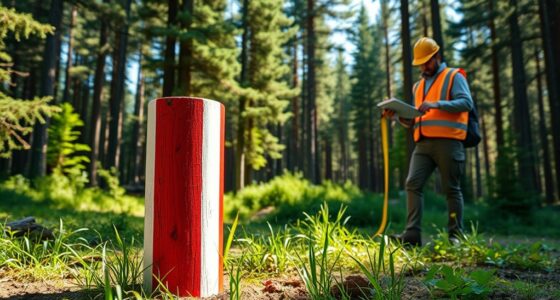To create and maintain effective firebreaks, start with thorough site assessment, considering fuel loads, weather, natural barriers, and ideal locations. Use techniques like removing surface fuels with tools or machinery, ensuring erosion control, and regularly inspecting for damage or regrowth. Employ materials such as bare soil or gravel, and utilize equipment like bulldozers and chainsaws. Continuous monitoring through technology and community involvement keeps firebreaks functional, helping you better protect your land and assets as you explore further solutions.
Key Takeaways
- Conduct thorough site assessments to identify natural and strategic locations for firebreaks based on fuel, weather, and terrain.
- Remove surface fuels and combustible vegetation using appropriate tools and machinery to create effective fire barriers.
- Incorporate erosion control measures and regular inspections to maintain firebreak integrity over time.
- Utilize technology such as remote sensing and GIS for monitoring vegetation regrowth and firebreak effectiveness.
- Engage communities and stakeholders in maintenance efforts, ensuring timely repairs and sustainable vegetation management.
Planning and Site Assessment
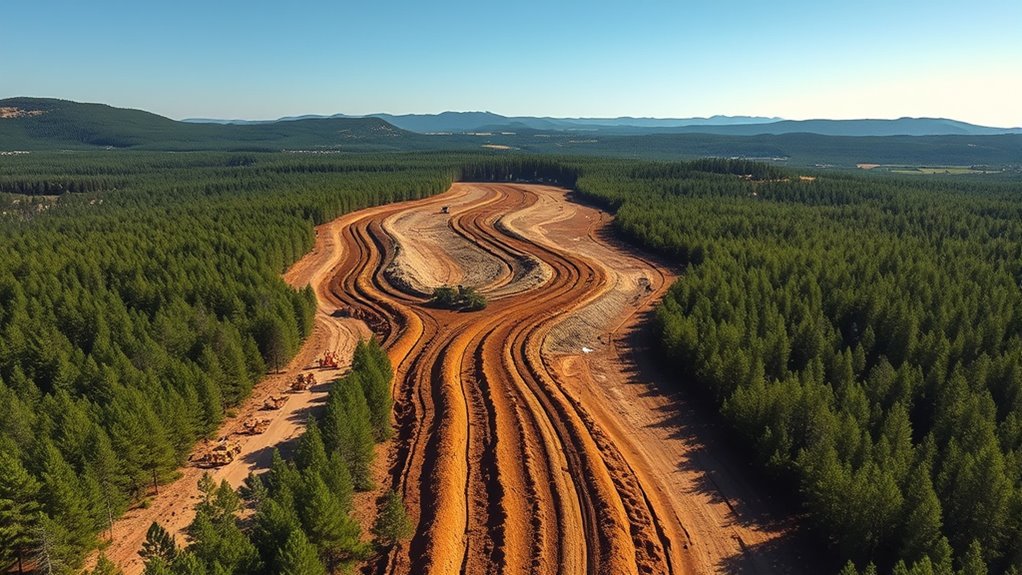
How do you determine the best location for a firebreak? First, assess the fuel load in the area. Identify sections with dense, dry vegetation that could fuel a fire. High fuel loads increase fire intensity, so placing firebreaks strategically helps contain potential blazes. Next, evaluate current weather conditions—hot, windy days elevate fire risk and influence fire behavior. Consider recent weather patterns; prolonged dry spells contribute to higher fuel loads and drier terrain. Look for natural firebreaks like rivers, rocky outcrops, or cleared areas that can be integrated into your plan. Combining knowledge of fuel load and weather conditions allows you to select a site that effectively interrupts fire spread, providing a crucial first line of defense. Proper site assessment is essential for planning a successful firebreak. Additionally, understanding firebreak creation techniques helps optimize the location and effectiveness of your firebreaks.
Techniques for Firebreak Construction
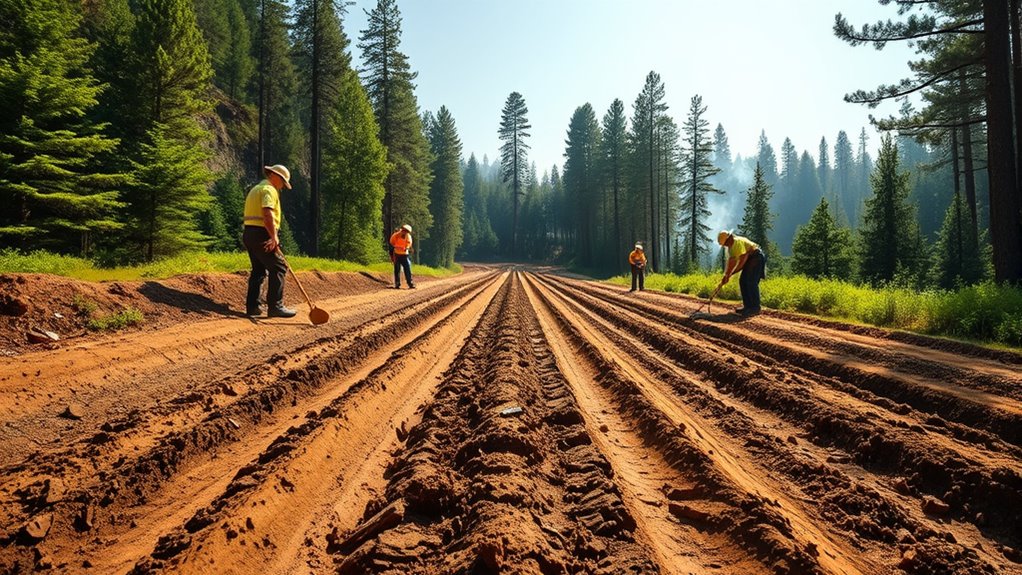
Constructing an effective firebreak requires careful selection of techniques that suit the terrain and vegetation. You should focus on vegetation removal, clearing combustible plants, shrubs, and fallen debris to create a continuous barrier. Using hand tools like trimmers or heavy machinery can make this process efficient, depending on the area’s size. Guarantee you remove surface fuels and undergrowth to eliminate fire ladders. Erosion control is essential during construction; avoid overly steep slopes, and consider terracing or installing erosion barriers to prevent soil runoff. Proper grading helps maintain the firebreak’s integrity over time. Regular inspections and maintenance are necessary to address any erosion or regrowth, ensuring the firebreak remains effective as a fire suppression tool. Additionally, vegetation management plays a crucial role in maintaining a safe and functional firebreak over the years. Incorporating monitoring and assessment strategies can help detect early signs of erosion or vegetation regrowth, allowing for timely intervention. Employing vetted techniques ensures these strategies are effective and sustainable. Incorporating fire behavior knowledge can further optimize the design and placement of firebreaks for maximum safety and efficiency. To enhance the longevity of the firebreaks, understanding erosion control methods is vital for preventing degradation over time.
Materials and Equipment for Firebreaks
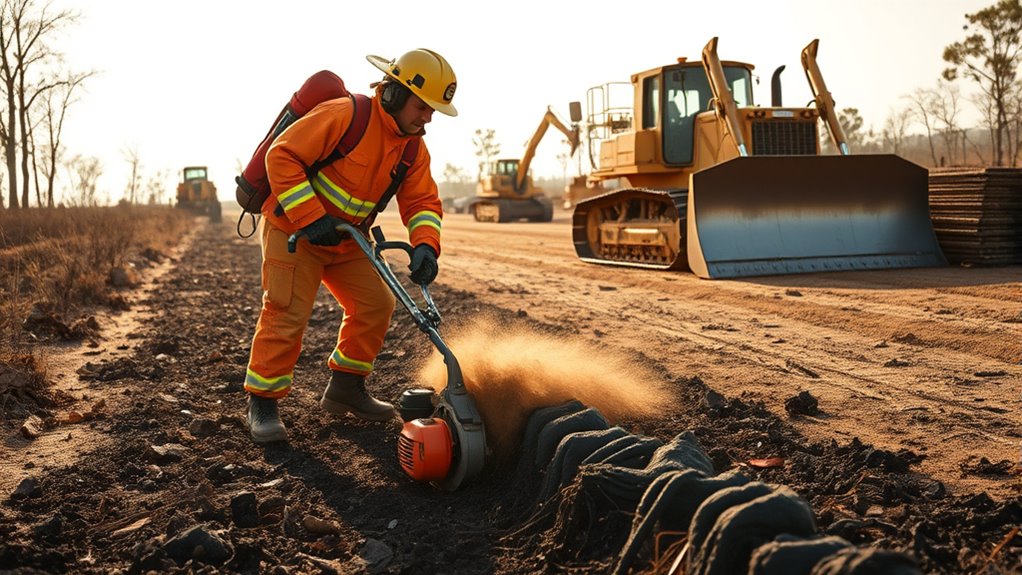
Creating effective firebreaks requires selecting the right materials and equipment to match the terrain and vegetation. Your choices influence success, safety, and efficiency. Common firebreak materials include bare soil, gravel, and cleared vegetation, which act as barriers to slow or stop fires. Firebreak equipment ranges from hand tools like shovels and rakes to machinery such as bulldozers and chainsaws, essential for clearing and shaping the break. Use the table below to understand material and equipment pairing:
| Material | Equipment | Purpose |
|---|---|---|
| Bare soil | Shovels, rakes | Remove combustible vegetation |
| Gravel | Heavy machinery | Stabilize firebreak edges |
| Cleared vegetation | Chainsaws, bulldozers | Create wide, clear barriers |
Choosing appropriate materials and equipment maximizes firebreak effectiveness and safety. Incorporating proper planning into your firebreak creation process can also significantly improve outcomes.
Maintenance and Monitoring Strategies
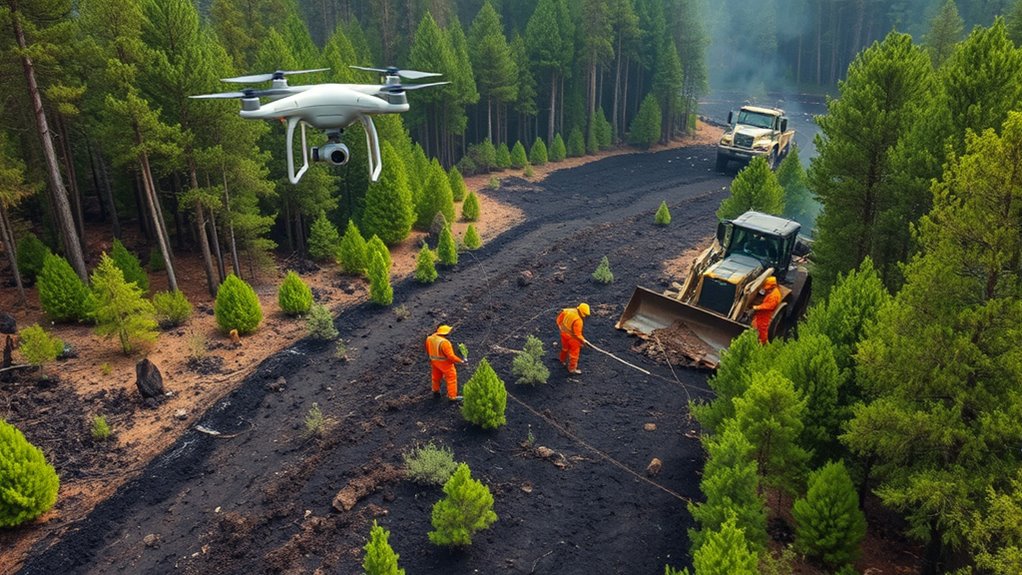
Regular maintenance and ongoing monitoring are essential to guarantee firebreaks remain effective over time. You need to regularly inspect the firebreaks for any signs of deterioration or encroachment. Securing consistent firebreak funding ensures you can afford routine upkeep and necessary repairs. Engaging the community keeps local stakeholders invested in firebreak preservation, encouraging prompt reporting of issues. To optimize your strategies, consider:
Regular inspections, community involvement, and diverse funding sustain effective firebreak maintenance over time.
- Conducting scheduled inspections and audits
- Using remote sensing or drone technology for monitoring
- Collaborating with local agencies for shared resources
- Educating residents about firebreak importance
- Securing diverse firebreak funding sources
Implementing advanced automation technologies can help streamline maintenance processes and improve response times. This approach helps maintain a resilient firebreak system that withstands environmental changes and human activity, ultimately reducing wildfire risks. Standardized communication about firebreaks enhances coordination and understanding among all involved parties. Community engagement amplifies your efforts, making maintenance more effective and sustainable. Additionally, integrating knowledge from firebreak maintenance practices can improve the longevity and effectiveness of your firebreaks. Regular assessments utilizing remote sensing methods can also provide comprehensive data on firebreak conditions, leading to more informed decision-making and ensuring the ongoing effectiveness of firebreaks.
Challenges and Solutions in Firebreak Management
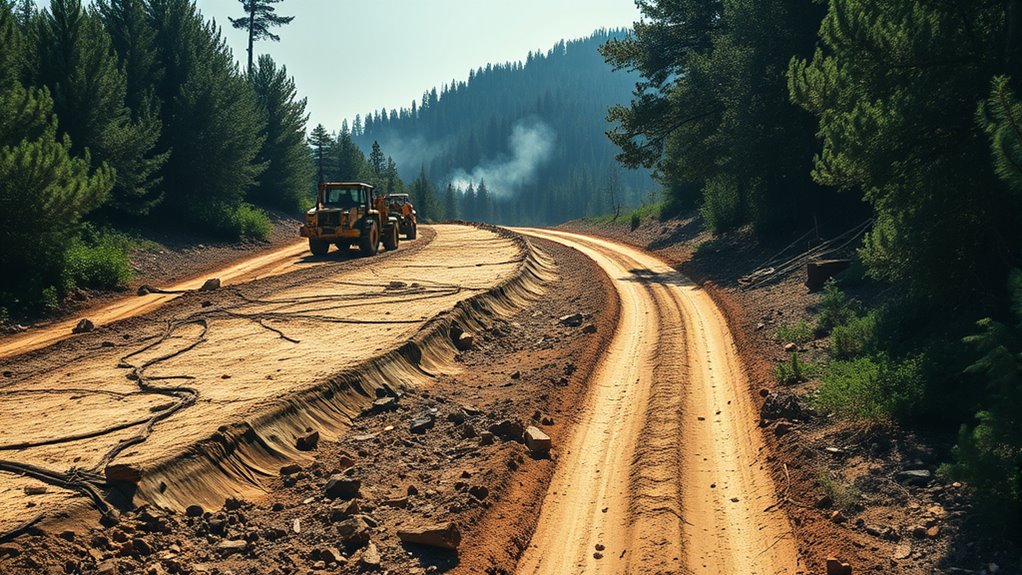
What are the main hurdles you face in managing firebreaks effectively? Maintaining firebreak effectiveness is often challenged by evolving vegetation, weather conditions, and human activity. Regular upkeep is essential, but it can be difficult to balance removal of combustible material without disrupting the surrounding ecosystem. Wildlife impact is a significant concern; clearing firebreaks may disturb habitats or displace animals. You need strategies that minimize ecological harm while ensuring firebreaks serve their purpose. You might also consider ecological balance when planning maintenance to support local biodiversity. Uncontrolled vegetation regrowth can weaken firebreaks, making them less reliable during fires. To address these issues, you can incorporate targeted clearing, controlled burning, and wildlife corridors. These solutions help maintain firebreak effectiveness while reducing negative effects on local wildlife, ensuring safer and more sustainable fire management practices. Additionally, understanding the importance of artistic innovations in public art can inspire creative approaches to ecological challenges, fostering community engagement and environmental awareness. Recognizing the role of tactical vegetation management can further enhance firebreak resilience by controlling regrowth and maintaining barrier integrity. Moreover, implementing regular monitoring is crucial for early detection of vegetation regrowth and potential vulnerabilities, enabling timely interventions. Incorporating advanced technology, such as remote sensing and GIS mapping, can also significantly improve the precision and efficiency of firebreak maintenance efforts.
Frequently Asked Questions
How Do Weather Conditions Affect Firebreak Effectiveness?
Weather conditions considerably impact firebreak effectiveness. You’ll find that weather patterns, like wind and temperature, influence how well a firebreak holds. Moisture levels are vital too; high humidity or recent rain can boost firebreak success by keeping vegetation damp, while dry, windy days increase fire risk. By understanding these factors, you can better plan and maintain firebreaks, ensuring they are more resilient during varying weather conditions.
What Are the Ecological Impacts of Firebreak Creation?
You might wonder about the ecological impacts of firebreak creation. Your actions can influence biodiversity effects, sometimes reducing habitat diversity or fragmenting ecosystems. Additionally, firebreaks can lead to increased soil erosion, especially if vegetation is removed without proper stabilization. While they help prevent wildfires, you should consider these impacts and implement measures that minimize ecological disruption, balancing safety with environmental health.
How Can Community Involvement Enhance Firebreak Maintenance?
Community involvement considerably boosts firebreak maintenance by fostering community engagement and volunteer programs. When you encourage local residents to participate, they become more invested in maintaining effective firebreaks, ensuring quicker responses and better upkeep. Volunteer programs empower you to tap into local knowledge and resources, making firebreaks more resilient. Your active engagement creates a sense of shared responsibility, ultimately strengthening fire prevention efforts and protecting your community from wildfires.
What Funding Options Are Available for Firebreak Projects?
When considering funding options, you should explore grant funding opportunities that support fire management projects. These grants often come from government agencies, environmental organizations, or local authorities. Additionally, partnership opportunities with community groups, businesses, or nonprofits can provide financial support or resources. By actively seeking these options, you can secure the necessary funding to effectively develop and maintain firebreaks, ensuring better wildfire prevention and community safety.
How to Adapt Firebreak Strategies for Urban Environments?
You should focus on integrating fire prevention into urban planning by creating defensible spaces and using fire-resistant materials. Adapt strategies like maintaining clear zones, installing firebreaks along vulnerable areas, and designing landscapes to reduce fuel. Collaborate with local authorities to develop zoning laws that prioritize fire safety. Regularly educate residents about fire risks and prevention, ensuring your urban environment minimizes fire spread while maintaining community aesthetics and function.
Conclusion
By understanding the essentials of firebreak creation, maintenance, and monitoring, you can stay ahead of wildfires and protect your land. With the right techniques, materials, and ongoing care, you’ll be well-equipped to keep fire hazards at bay. Remember, an ounce of prevention is worth a pound of cure—don’t wait until it’s too late. Stay vigilant, adapt as needed, and you’ll find that preparedness truly pays off when fire risks loom large.


